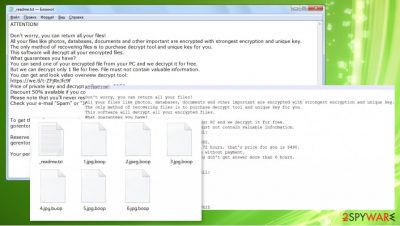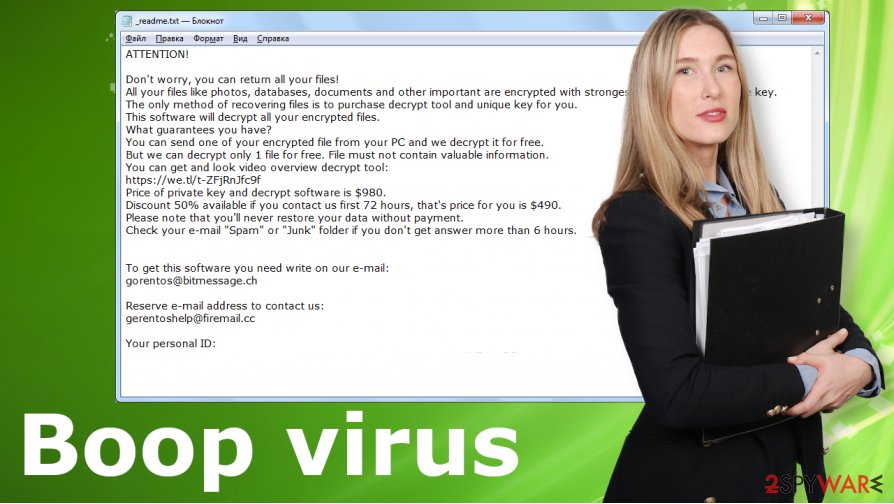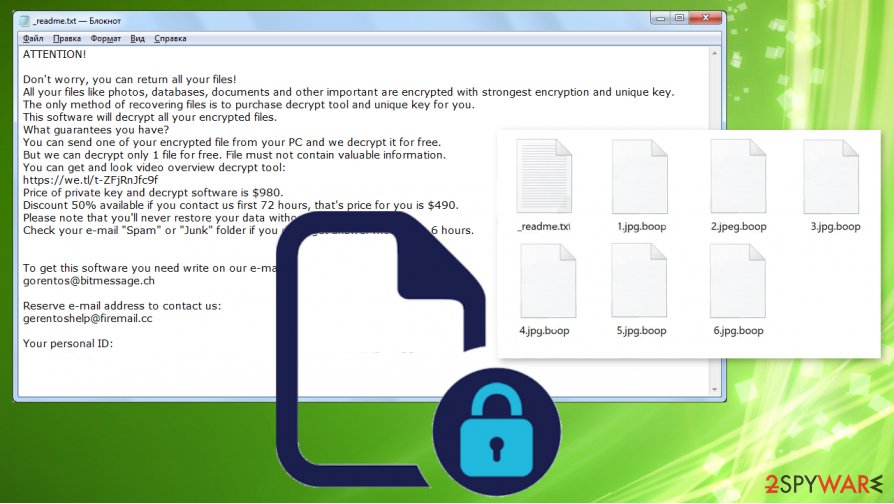Boop ransomware (Virus Removal Guide) - Decryption Steps Included
Boop virus Removal Guide
What is Boop ransomware?
Boop ransomware is the threat that is designed with the purpose of encrypting files and getting money from victims directly

There are no good reasons that should encourage you to pay for the creators of this notorious Boop ransomware virus because criminals behind the threat focus on manipulations and deceptiveness. This is the latest version reported by victims online[1], but it is the identical virus based on year-old functionality. Files virus works and displays the same features, functions, and symptoms as the previous variants released in the month of August 2020 – Vari and Oonn.
Boop files virus is not decryptable at the moment. Even though some files might get repaired using the decryption tool or media file recovery program[2], the initial version uses online IDs – the unique keys formed for each victim separately. There are not many solutions for such infections, so the sooner you get rid of it the better. Then the option of file backups can be helpful.
| Name | Boop virus |
|---|---|
| Type | Ransomware/ Cryptovirus |
| Family | STOP ransomware virus is the initial threat that released Djvu as a version back in 2016. From there criminals focused on spreading new threats weekly or more often than that |
| File appendix | .boop is the extension that gets added at the end of every affected file |
| Ransom note | _readme.txt – the file containing a message from criminals with the money demand and more information |
| Contact information | helpmanager@mail.ch and restoremanager@airmail.cc |
| Distribution | The threat family is known for relying on malicious files as the main distribution method. This is how versions manage to spread. The script is injected on the machine from spam email attachments and from pirated software files and during such processes that involve unreliable sources |
| Elimination | Boop ransomware removal procedures involve anti-malware tools and file recovery programs once the machine is fully cleared from malware |
| Repair of the OS | You should recover the system and files damaged by the threat before you do anything else. You can achieve that with proper repair tools that can find and fix corrupted parts for you. Try FortectIntego for the job |
Boop ransomware is not the program that could be easily removed from the machine because it is not an application this is a dangerous infection. The purpose of the threat is to infect machines and encrypt files with the aim to get direct payments of the cryptocurrency. Money is the goal of criminals behind the ransomware.
Once files get encrypted by the Boop ransomware virus those documents, images, archive files, and even databases get .boop appendix after the original name and filetype-indicating extension. Once files get locked and _readme.txt file loaded on the desktop, in other folders, you can be sure that the encryption procedure is done.
This message from developers of the virus indicates that the only option to get your files back os to pay for the decryption tool. But this is not the recommended method when you need to recover Boop ransomware encrypted files. There are many risks that come after the contact between you as a victim and criminals as extortionists.
The message indicates what happened and what options you have. Also, the particular ransom amount is displayed there:
ATTENTION!
Don’t worry, you can return all your files!
All your files like photos, databases, documents and other important are encrypted with strongest encryption and unique key.
The only method of recovering files is to purchase decrypt tool and unique key for you.
This software will decrypt all your encrypted files.
What guarantees you have?
You can send one of your encrypted file from your PC and we decrypt it for free.
But we can decrypt only 1 file for free. File must not contain valuable information.
You can get and look video overview decrypt tool:
https://we.tl/t-gSEEREZ5tS
Price of private key and decrypt software is $980.
Discount 50% available if you contact us first 72 hours, that’s price for you is $490.
Please note that you’ll never restore your data without payment.
Check your e-mail “Spam” or “Junk” folder if you don’t get answer more than 6 hours.To get this software you need write on our e-mail:
helpmanager@mail.chReserve e-mail address to contact us:
restoremanager@firemail.ccYour personal ID:
You need to ignore the demand for payment from these Boop ransomware creators. There are no better options than to remove the virus and replace files affected by the malware. Paying is not recommended by experts[3] because money can be lost alongside your files when the demanded amount is transferred but decryption tools not provided.
Process of Boop virus encryption: difference in online and offline IDs
There are many versions in the family of STOP ransomware virus. This one carrying the .boop file appendix is 247th on the list of different variants. It comes a year after the last decryptable versions that came out before August 2019. After that, the previously used STOPDecrypter became useless and no longer supported.
The tool worked on the basis of offline victim IDs. This function allowed researchers to recover many files encoded by the same version by using one of the keys associated with the variant. It worked for many users and victims got their files recovered. However, cybercriminals renewed the coding and added new more powerful features. Boop ransomware virus is one of the more advanced versions.
.boop files virus uses online IDs, so each victim gets a unique key that is needed for decryption. It is formed by connecting to the server online that determines a particular identification key. This is sad news for victims, because the only option for file recovery – data backups are not up to date, in most of the cases.
You need to remove .boop files virus as soon as you get the ransom note delivered to your screen. You need proper anti-malware tools or security programs like SpyHunter 5Combo Cleaner or Malwarebytes, so your system is checked and all the traces of malware detected, fully eliminated.

Boop ransomware removal solutions and methods are closely related to the distribution of this threat. There are various methods involving malicious files that get used to spreading the threat, but the main technique involves pirating software and insecure online sources.
You may have less opportunity to remove Boop ransomware completely from the machine when the threat manages to alter settings, add other programs or damage files on the computer. This is why we recommend getting proper anti-malware tools for the job and running the scan[4] on your system that detects and remove threats entirely.
Boop ransomware removal is not the same as .boop file recovery
Even though it might be possible to restore files after the Boop ransomware attack with your file backups or decryption tool when your versions are based on offline IDs, data can get damaged permanently. The best solution for infection like this is data backups on external devices or cloud services. Third-party options might also work.
However, you need to remove Boop virus completely off of the system before you start anything like that. You risk getting your existing files encrypted another time, which makes them useless forever. And ransomware can encrypt recovered files or replaced data from scratch.
Make the system virus-free again and only then rely on file recovery options. Do not allow the threat to affect the system further. Boop ransomware file recovery options might consist of some Windows OS features, third-party recovery applications previously developed decryption tools. Some of them are listed below.

Make sure to eliminate traces of the Boop ransomware virus and get rid of the virus fully before focusing on data
The proper system scan is needed for the best results of the Boop ransomware removal. Anti-malware tools or security software like SpyHunter 5Combo Cleaner or Malwarebytes can fully check the machine, locate malware traces, programs associated with the virus, and remove them once and for all. This is the best option for the cryptovirus like that.
Boop ransomware virus is a persistent threat and can make this termination procedure more difficult by adding other processes, files, or malicious programs on the system. If that happens, you need more help to recover from such an infection. Especially, when your data gets affected.
No matter what cryptovirus you get on the PC, you need to delete it. So remove Boop ransomware from the machine using AV tool, then rely on PC repair applications like FortectIntego and repair the damaged files, corrupted system functions. Once these two steps are done, you can focus on file recovery. Encrypted data can be damaged permanently, but there are some options below. Paying is not one of them.
Getting rid of Boop virus. Follow these steps
Manual removal using Safe Mode
The system can be cleared from the malware like Boop ransomware virus if you rely on Safe Mode with Netwoking
Important! →
Manual removal guide might be too complicated for regular computer users. It requires advanced IT knowledge to be performed correctly (if vital system files are removed or damaged, it might result in full Windows compromise), and it also might take hours to complete. Therefore, we highly advise using the automatic method provided above instead.
Step 1. Access Safe Mode with Networking
Manual malware removal should be best performed in the Safe Mode environment.
Windows 7 / Vista / XP
- Click Start > Shutdown > Restart > OK.
- When your computer becomes active, start pressing F8 button (if that does not work, try F2, F12, Del, etc. – it all depends on your motherboard model) multiple times until you see the Advanced Boot Options window.
- Select Safe Mode with Networking from the list.

Windows 10 / Windows 8
- Right-click on Start button and select Settings.

- Scroll down to pick Update & Security.

- On the left side of the window, pick Recovery.
- Now scroll down to find Advanced Startup section.
- Click Restart now.

- Select Troubleshoot.

- Go to Advanced options.

- Select Startup Settings.

- Press Restart.
- Now press 5 or click 5) Enable Safe Mode with Networking.

Step 2. Shut down suspicious processes
Windows Task Manager is a useful tool that shows all the processes running in the background. If malware is running a process, you need to shut it down:
- Press Ctrl + Shift + Esc on your keyboard to open Windows Task Manager.
- Click on More details.

- Scroll down to Background processes section, and look for anything suspicious.
- Right-click and select Open file location.

- Go back to the process, right-click and pick End Task.

- Delete the contents of the malicious folder.
Step 3. Check program Startup
- Press Ctrl + Shift + Esc on your keyboard to open Windows Task Manager.
- Go to Startup tab.
- Right-click on the suspicious program and pick Disable.

Step 4. Delete virus files
Malware-related files can be found in various places within your computer. Here are instructions that could help you find them:
- Type in Disk Cleanup in Windows search and press Enter.

- Select the drive you want to clean (C: is your main drive by default and is likely to be the one that has malicious files in).
- Scroll through the Files to delete list and select the following:
Temporary Internet Files
Downloads
Recycle Bin
Temporary files - Pick Clean up system files.

- You can also look for other malicious files hidden in the following folders (type these entries in Windows Search and press Enter):
%AppData%
%LocalAppData%
%ProgramData%
%WinDir%
After you are finished, reboot the PC in normal mode.
Remove Boop using System Restore
System Restore can properly recover the machine in a state when the virus was not active
-
Step 1: Reboot your computer to Safe Mode with Command Prompt
Windows 7 / Vista / XP- Click Start → Shutdown → Restart → OK.
- When your computer becomes active, start pressing F8 multiple times until you see the Advanced Boot Options window.
-
Select Command Prompt from the list

Windows 10 / Windows 8- Press the Power button at the Windows login screen. Now press and hold Shift, which is on your keyboard, and click Restart..
- Now select Troubleshoot → Advanced options → Startup Settings and finally press Restart.
-
Once your computer becomes active, select Enable Safe Mode with Command Prompt in Startup Settings window.

-
Step 2: Restore your system files and settings
-
Once the Command Prompt window shows up, enter cd restore and click Enter.

-
Now type rstrui.exe and press Enter again..

-
When a new window shows up, click Next and select your restore point that is prior the infiltration of Boop. After doing that, click Next.


-
Now click Yes to start system restore.

-
Once the Command Prompt window shows up, enter cd restore and click Enter.
Bonus: Recover your data
Guide which is presented above is supposed to help you remove Boop from your computer. To recover your encrypted files, we recommend using a detailed guide prepared by 2-spyware.com security experts.If your files are encrypted by Boop, you can use several methods to restore them:
Data Recovery Pro is the program that can act as an alternative for the data backup
Try to restore files affected by Boop ransomware virus with Data Recovery Pro
- Download Data Recovery Pro;
- Follow the steps of Data Recovery Setup and install the program on your computer;
- Launch it and scan your computer for files encrypted by Boop ransomware;
- Restore them.
Windows Previous Versions feature is the solution for encrypted data
When you deal with encoded files, you need a proper solution for the file recovery. Using system restore enables this Windows Previous Versions functionality
- Find an encrypted file you need to restore and right-click on it;
- Select “Properties” and go to “Previous versions” tab;
- Here, check each of available copies of the file in “Folder versions”. You should select the version you want to recover and click “Restore”.
Rely on ShadowExplorer and restore encoded data yourself
When shadow Volume Copies are left untouched, you can restore files by using ShadowExplorer
- Download Shadow Explorer (http://shadowexplorer.com/);
- Follow a Shadow Explorer Setup Wizard and install this application on your computer;
- Launch the program and go through the drop down menu on the top left corner to select the disk of your encrypted data. Check what folders are there;
- Right-click on the folder you want to restore and select “Export”. You can also select where you want it to be stored.
Try the Djvu decryptor as a possible solution
Boop virus is one of the more recent versions that have no decryption options, but you can rely on the tool designed for other Djvu versions and check if the decryption is possible
Finally, you should always think about the protection of crypto-ransomwares. In order to protect your computer from Boop and other ransomwares, use a reputable anti-spyware, such as FortectIntego, SpyHunter 5Combo Cleaner or Malwarebytes
How to prevent from getting ransomware
Stream videos without limitations, no matter where you are
There are multiple parties that could find out almost anything about you by checking your online activity. While this is highly unlikely, advertisers and tech companies are constantly tracking you online. The first step to privacy should be a secure browser that focuses on tracker reduction to a minimum.
Even if you employ a secure browser, you will not be able to access websites that are restricted due to local government laws or other reasons. In other words, you may not be able to stream Disney+ or US-based Netflix in some countries. To bypass these restrictions, you can employ a powerful Private Internet Access VPN, which provides dedicated servers for torrenting and streaming, not slowing you down in the process.
Data backups are important – recover your lost files
Ransomware is one of the biggest threats to personal data. Once it is executed on a machine, it launches a sophisticated encryption algorithm that locks all your files, although it does not destroy them. The most common misconception is that anti-malware software can return files to their previous states. This is not true, however, and data remains locked after the malicious payload is deleted.
While regular data backups are the only secure method to recover your files after a ransomware attack, tools such as Data Recovery Pro can also be effective and restore at least some of your lost data.
- ^ .boop extension decryption key. Reddit. Online community.
- ^ Media-Repair. Small repair tool for MP3 and WAV files affected by STOP/DJVU. Disktuna. Repair files.
- ^ Dieviren. Dieviren. Spyware related threats.
- ^ Boop virus detection rate. VirusTotal. Online malware scanner.





















